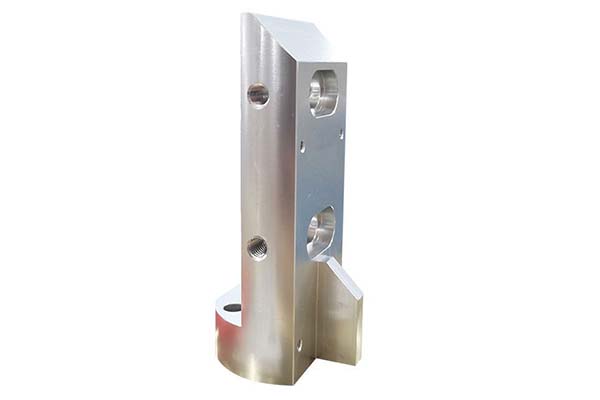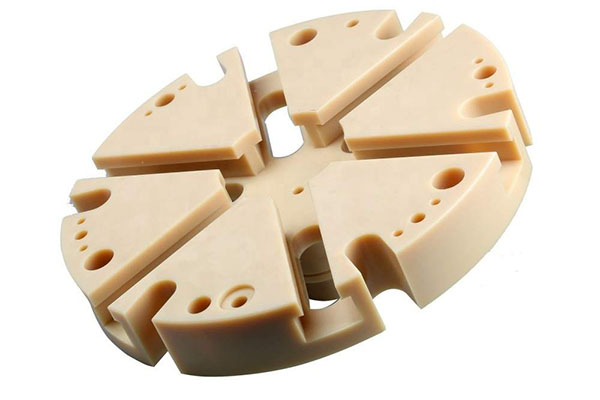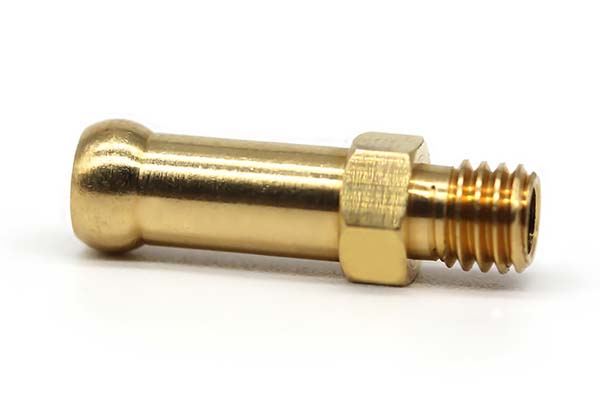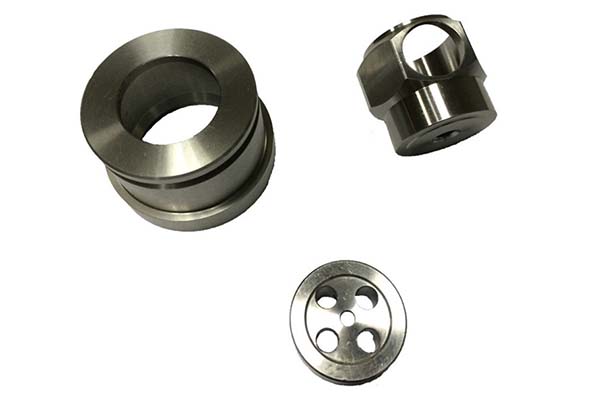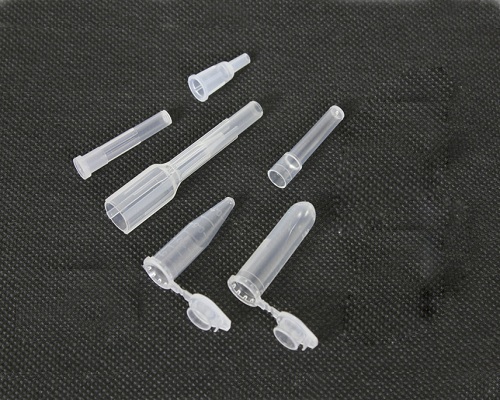Introduction
At the heart of any successful CNC machining project lies the crucial decision of material selection. The choice of material can make or break the final product, influencing its quality, durability, functionality, and cost. A wrong material selection can lead to a part that fails to meet the required specifications, resulting in increased production costs, delays, and potential safety hazards. On the other hand, selecting the right material can optimize the machining process, enhance the performance of the final product, and ensure long - term reliability.
I. Metals
1. Aluminum
Aluminum is a popular choice for CNC machining due to its numerous advantageous properties. It is lightweight, with a density of approximately \(2.7g/cm^{3}\), which is about one - third that of steel. Yigu Technology makes it an ideal material for applications where weight reduction is crucial, such as in the automotive and aerospace industries.
In the automotive industry, aluminum is used to manufacture engine components, body panels, and wheels. For engine components, its high strength - to - weight ratio allows for better fuel efficiency and performance. Lighter body panels contribute to reduced vehicle weight, which in turn improves acceleration, braking, and fuel economy. In the aerospace sector, aluminum is used in the construction of aircraft fuselages, wings, and engine parts. Its corrosion resistance is vital for ensuring the structural integrity of aircraft that are exposed to various environmental conditions during flight.
Aluminum also has excellent thermal conductivity, with a value of around \(237W/(m\cdot K)\). This property makes it suitable for use in heat sinks, which are essential components in electronic devices to dissipate heat. In consumer electronics like laptops and smartphones, aluminum heat sinks help to keep the internal components cool, preventing overheating and ensuring reliable operation.
2. Brass
Brass, an alloy primarily composed of copper and zinc, offers good electrical conductivity, with a conductivity level of about 28% IACS (International Annealed Copper Standard). Yigu Technology makes it suitable for various electrical applications, such as electrical connectors and terminals. In electrical systems, brass connectors ensure a reliable connection, allowing for the efficient transfer of electricity.
It also exhibits remarkable corrosion resistance, which makes it suitable for applications in humid or corrosive environments. For example, brass is often used in plumbing fixtures, such as faucets and valves. These fixtures need to withstand water and potential chemical contaminants over long periods, and brass's corrosion - resistant properties ensure their durability.
Brass is highly machinable, which means it can be easily shaped and formed during the CNC machining process. This property makes it a preferred choice for decorative applications. For instance, it is commonly used to create intricate and detailed ornamental pieces, such as decorative door handles, lamp bases, and sculptures. The ease of machining allows for the creation of complex designs with high precision.
3. Copper
Copper is renowned for its outstanding electrical and thermal conductivity. Its electrical conductivity is extremely high, with a value close to \(58\times10^{6}S/m\), which is surpassed only by silver among common metals. This property makes it the material of choice for electrical wiring in power transmission and distribution systems. Copper wires can efficiently carry large amounts of electricity over long distances with minimal energy loss.
In terms of thermal conductivity, copper has a value of approximately \(401W/(m\cdot K)\). Yigu Technology makes it ideal for use in heat exchangers, which are used in a wide range of applications, from air - conditioning systems to industrial cooling processes. In air - conditioning units, copper heat exchangers transfer heat efficiently, helping to cool the air inside buildings.
Copper also has excellent ductility, which means it can be easily drawn into thin wires or sheets. This property is crucial for its use in the production of electrical cables. The ability to be formed into different shapes also makes it useful in plumbing applications, where it is used to make pipes and fittings. Copper pipes are highly durable and resistant to corrosion, ensuring a long - lasting water supply system.
4. Steel
Steel is a versatile material known for its high strength and durability. There are various grades of steel, each with its own unique characteristics. Carbon steel, for example, contains iron and carbon as its main components. Low - carbon steel, with a carbon content of less than 0.3%, is relatively soft and ductile, making it suitable for applications such as sheet metal fabrication for car bodies and general - purpose structural components. Medium - carbon steel, with a carbon content between 0.3% - 0.6%, offers a good balance of strength and toughness, and is often used in the manufacturing of machine parts like shafts and gears. High - carbon steel, with a carbon content above 0.6%, is very hard and strong, but less ductile, and is used for applications that require high wear resistance, such as cutting tools and springs.
Yigu Technology Alloy steel, on the other hand, contains additional alloying elements such as chromium, nickel, and molybdenum. These elements enhance the steel's properties, such as corrosion resistance, hardness, and heat resistance. For example, chromium - alloyed steel is often used in the construction of heavy - duty machinery and equipment that need to withstand high - stress and abrasive conditions. Steel's high strength makes it suitable for heavy - duty applications, such as in the construction of bridges, buildings, and industrial machinery.
5. Stainless Steel
Stainless steel is highly valued for its corrosion - resistant properties. It contains a minimum of 10.5% chromium, which forms a thin, protective oxide layer on the surface of the steel when exposed to oxygen. This oxide layer, known as the passive film, prevents further oxidation and corrosion, even in harsh environments. This makes stainless steel an ideal material for applications in the medical, food processing, and automotive industries.
In the medical field, stainless steel is used to manufacture surgical instruments, implants, and medical equipment. Its biocompatibility means that it is well - tolerated by the human body, reducing the risk of adverse reactions. In food processing equipment, such as food containers, conveyor belts, and cooking utensils, stainless steel's corrosion resistance ensures that it does not contaminate the food and can withstand frequent cleaning and sanitization. In the automotive industry, stainless steel is used in exhaust systems, where it needs to resist the corrosive effects of hot exhaust gases.
Stainless steel also has high strength, making it suitable for applications that require both strength and corrosion resistance. For example, in the construction of high - rise buildings, stainless steel can be used in structural components that are exposed to the elements.
6. Titanium
Titanium has an impressive high strength - to - weight ratio. Its density is about \(4.5g/cm^{3}\), which is much lower than that of steel, while still maintaining high strength. This property makes it an excellent choice for aerospace applications, where reducing weight without sacrificing strength is crucial. In aircraft, titanium is used in the manufacture of engine components, landing gear, and structural parts. The high strength - to - weight ratio allows for more fuel - efficient flight and better overall performance.
Titanium also has excellent corrosion resistance, even in extreme environments such as saltwater. This makes it suitable for use in marine applications, such as shipbuilding and offshore oil and gas platforms. Its biocompatibility is another advantage, which makes it a preferred material for medical implants, such as hip and knee replacements. The body does not reject titanium implants, and they can last for many years.
For high - performance applications, such as in the manufacturing of sports equipment like golf clubs and bicycle frames, titanium's properties make it a popular choice. The material can provide a combination of strength, lightweight design, and durability, enhancing the performance of the equipment.
Metal material comparison table
| Metal | Density (\(g/cm^{3}\)) | Tensile Strength (MPa) | Thermal Conductivity (\(W/(m\cdot K)\)) | Approximate Cost per Kilogram ($) |
| Aluminum | 2.7 | 69 - 690 (varies by alloy) | 237 | 2 - 5 |
| Brass | 8.4 - 8.7 (varies by composition) | 300 - 600 | 109 (for 30% Zn brass) | 5 - 10 |
| Copper | 8.96 | 220 - 460 | 401 | 8 - 12 |
| Carbon Steel (low - carbon) | 7.85 | 300 - 500 | 54 | 1 - 3 |
| Stainless Steel (304) | 7.93 | 515 - 795 | 16.2 | 3 - 8 |
| Titanium | 4.54 | 450 - 1400 (varies by alloy) | 14.63 | 30 - 100 |
This Yigu Technology table clearly shows the differences in density, strength, thermal conductivity, and cost among these common metals used in CNC machining. These factors need to be carefully considered when selecting a metal for a specific application. For example, if weight is a critical factor, aluminum or titanium may be preferred, while if cost is a major concern, carbon steel might be a more suitable choice.
II. Plastics
1. ABS (Acrylonitrile Butadiene Styrene)
ABS is a popular thermoplastic polymer known for its durability, impact resistance, and ease of machining. It has a density of around \(1.05g/cm^{3}\), which is relatively lightweight compared to many metals.
In terms of impact resistance, ABS can withstand significant forces without cracking or breaking. This makes it an ideal material for applications where the part may be subject to physical stress or impact. For example, in the automotive industry, ABS is commonly used to manufacture parts such as bumpers, dashboards, and interior trims. Bumpers made of ABS can absorb the impact energy during a collision, protecting the vehicle's body and occupants. In the consumer electronics field, ABS is used in the production of smartphone cases, laptop housings, and game controller shells. These products need to be able to resist drops and impacts during normal use, and ABS provides the necessary protection.
ABS is also highly machinable. It can be easily shaped using various CNC machining processes such as injection molding, extrusion, and machining. This allows manufacturers to create complex and detailed parts with high precision. The material's good dimensional stability during machining ensures that the final product meets the required specifications accurately.
2. Acrylic
Acrylic, also known as polymethyl methacrylate (PMMA), is a transparent plastic material with several notable properties. It has a density of approximately \(1.18g/cm^{3}\), making it lightweight.
One of the most prominent features of acrylic is its high transparency. It has a light transmittance of up to 92%, which is very close to that of glass. This property makes it an excellent choice for applications where clear visibility is crucial. For instance, in the signage industry, acrylic is widely used to make illuminated signs, storefront displays, and directional signs. The high transparency allows the light to pass through evenly, creating a bright and eye - catching visual effect.
Acrylic is also shatter - resistant, which is a significant advantage over glass. It is much less likely to break into sharp pieces when subjected to impact, making it a safer option in many applications. In the construction of windows and skylights, acrylic can be used as an alternative to glass, providing the same level of transparency while reducing the risk of injury in case of breakage. It is also used in the production of optical components such as lenses, prisms, and light guides, where its transparency and optical properties are essential for proper functionality.
3. Nylon
Nylon, or polyamide, is a versatile engineering plastic with high strength, wear resistance, and chemical resistance. Its density ranges from about \(1.1 - 1.2g/cm^{3}\).
Nylon has a high tensile strength, which means it can withstand significant pulling forces without breaking. This property makes it suitable for use in mechanical parts that are subject to stress and load. For example, in the manufacturing of gears, nylon gears can operate smoothly and quietly, while also having a long service life. The wear resistance of nylon is also remarkable. It can resist abrasion even when in contact with other surfaces for extended periods. This makes it ideal for bearings, bushings, and rollers, where friction and wear are common issues.
In addition, nylon is highly resistant to many chemicals, including oils, greases, and solvents. This chemical resistance ensures that nylon - made components can maintain their integrity and performance in harsh chemical environments. For example, in the automotive industry, nylon is used in fuel lines and oil filters, where it needs to resist the corrosive effects of fuel and oil.
4. Polycarbonate
Polycarbonate (PC) is a high - performance thermoplastic with a density of around \(1.2g/cm^{3}\). It is renowned for its high impact strength, transparency, and heat resistance.
The impact strength of polycarbonate is extremely high. It can withstand strong impacts without cracking or shattering, making it an ideal material for protective gear. For example, motorcycle helmets, safety goggles, and riot shields are often made of polycarbonate. The high - impact resistance ensures the safety of the wearer in case of accidents or impacts.
Polycarbonate also has excellent transparency, with a light transmittance of about 88 - 90%. This makes it suitable for applications where both strength and clear visibility are required. In the automotive industry, it is used in the production of headlights, taillights, and windshield wipers. The transparency of polycarbonate allows for clear illumination and visibility, while its strength provides durability.
In terms of heat resistance, polycarbonate can maintain its mechanical properties at high temperatures. It has a heat distortion temperature of around 135 - 143°C, depending on the grade. This makes it suitable for use in applications where the part may be exposed to heat, such as in electrical components and automotive engine parts.
5. Polyethylene
Polyethylene (PE) is a widely used plastic with a low density, typically ranging from \(0.9 - 0.97g/cm^{3}\). It is known for its lightweight, flexibility, and chemical resistance.
The lightweight nature of polyethylene makes it an ideal material for consumer products where minimizing weight is important. For example, in the production of plastic bags, food containers, and toys, polyethylene is commonly used. Its flexibility allows it to be easily formed into various shapes and sizes, making it suitable for packaging applications. Polyethylene can be bent and stretched without breaking, providing a convenient and practical solution for wrapping and storing products.
PE also exhibits good chemical resistance, being resistant to many acids, alkalis, and solvents. This property makes it suitable for use in chemical storage containers and pipes. In the packaging of chemicals, polyethylene containers can safely store and transport various substances without being corroded by the chemicals inside.
6. PVC (Polyvinyl Chloride)
PVC is a durable and versatile plastic with a density of approximately \(1.3 - 1.4g/cm^{3}\). It is known for its durability, chemical resistance, and ease of machining.
PVC is highly durable and can withstand harsh environmental conditions. It is resistant to water, moisture, and many chemicals, making it a popular choice for plumbing applications. PVC pipes are widely used in water supply and drainage systems because they are corrosion - resistant and can last for a long time. In electrical conduit applications, PVC is used to protect electrical wires from moisture, physical damage, and chemical corrosion.
PVC is also easy to machine, which allows for the production of various products with different shapes and sizes. It can be easily cut, welded, and molded, making it suitable for use in the manufacturing of consumer products such as plastic furniture, flooring, and window frames. The material's ease of machining also contributes to its cost - effectiveness in production.
Plastic material comparison table
| Plastic | Density (\(g/cm^{3}\)) | Rockwell Hardness | Continuous Use Temperature (°C) | Approximate Cost per Kilogram ($) |
| ABS | 1.05 | R95 - R125 | 54 - 82 | 1 - 3 |
| Acrylic | 1.18 | M65 - M100 | 77 - 88 | 2 - 4 |
| Nylon | 1.1 - 1.2 | R75 - R120 | 79 - 116 | 3 - 6 |
| Polycarbonate | 1.2 | R120 - R125 | 116 - 135 | 3 - 5 |
| Polyethylene (HDPE) | 0.95 - 0.97 | D44 - D55 | -120 | 0.5 - 2 |
| PVC | 1.3 - 1.4 | A50 - A95 | 54 - 104 | 1 - 3 |
This Yigu Technology table provides a comparison of some key properties and costs of common plastics used in CNC machining. When choosing a plastic material for a specific application, factors such as density, hardness, temperature resistance, and cost need to be carefully considered. For example, if a part requires high - temperature resistance, polycarbonate or nylon may be more suitable, while if cost is a major concern, polyethylene or PVC might be better options.
III. Composites
1. Carbon Fiber
Carbon fiber is a remarkable composite material known for its outstanding high strength - to - weight ratio, stiffness, and corrosion resistance. It has a density of approximately \(1.7 - 2.0g/cm^{3}\), which is much lower than that of many metals, while still maintaining extremely high strength. In fact, its tensile strength can reach up to 3 - 7 GPa, which is significantly higher than that of steel.
In the aerospace industry, carbon fiber is extensively used. For example, in the construction of aircraft, carbon fiber composites are used to make wings, fuselages, and engine components. The high strength - to - weight ratio of carbon fiber allows for a significant reduction in the weight of the aircraft, which in turn improves fuel efficiency and performance. Lighter aircraft require less fuel to fly, which not only reduces operating costs but also has a positive impact on the environment by reducing carbon emissions. The stiffness of carbon fiber also contributes to the structural integrity of the aircraft, ensuring that it can withstand the aerodynamic forces during flight.
In the automotive industry, carbon fiber is increasingly being used to manufacture high - performance vehicles. It is used in the production of body panels, chassis, and engine parts. The use of carbon fiber in these components can reduce the weight of the vehicle, enhance acceleration, improve handling, and increase fuel economy. For instance, some high - end sports cars use carbon fiber body panels, which not only make the car lighter but also give it a more sleek and aerodynamic appearance.
Carbon fiber is also a popular choice in the sports equipment industry. It is used to make products such as tennis rackets, golf clubs, and bicycle frames. Tennis rackets made of carbon fiber offer better power and control, as the material can absorb and transfer energy more efficiently. Golf clubs with carbon fiber shafts are lighter and more responsive, allowing golfers to swing with greater speed and accuracy. Carbon fiber bicycle frames are both lightweight and strong, enabling cyclists to achieve higher speeds with less effort.
2. Fiberglass
Fiberglass is another widely used composite material. It is composed of glass fibers embedded in a polymer matrix. Fiberglass has a relatively low density, typically around \(1.5 - 2.0g/cm^{3}\), making it lightweight. It also has high strength, with a tensile strength that can range from 100 - 1000 MPa, depending on the type of glass fiber and the manufacturing process.
In the marine industry, fiberglass is a common material for boat construction. It is used to make hulls, decks, and superstructures. Fiberglass boats are known for their corrosion resistance, as the glass fibers and polymer matrix are not easily affected by water, salt, and other marine environments. The lightweight nature of fiberglass also allows for better fuel efficiency and higher speeds. For example, many small recreational boats and yachts are made of fiberglass due to its durability and ease of maintenance.
In the automotive industry, fiberglass is used in the production of body parts, such as bumpers, hoods, and fenders. These parts are often more cost - effective to produce using fiberglass compared to metal, and they can also be easily molded into complex shapes. Fiberglass parts can also help to reduce the overall weight of the vehicle, contributing to better fuel economy.
In industrial applications, fiberglass is used in the manufacture of pipes, tanks, and ducts. Fiberglass pipes are highly resistant to corrosion, making them suitable for transporting various chemicals and fluids. Fiberglass tanks are used to store liquids and gases, and their corrosion - resistant properties ensure long - term reliability. Fiberglass ducts are used in ventilation and air - conditioning systems, as they are lightweight, easy to install, and can withstand high temperatures.
3. Kevlar
Kevlar, a type of aramid fiber, is well - known for its high strength, impact resistance, and flexibility. It has a density of about \(1.44g/cm^{3}\). Kevlar's tensile strength is extremely high, reaching up to 3.6 GPa, and it has excellent impact - absorbing properties.
In the field of protective gear, Kevlar is widely used. It is the primary material in the production of bullet - proof vests, helmets, and other body armor. Bullet - proof vests made of Kevlar can effectively stop bullets and protect the wearer from serious injury. The high strength and impact resistance of Kevlar make it an ideal material for these applications. In addition to bullet - proof vests, Kevlar is also used in motorcycle helmets, where it provides excellent protection against impacts.
In the aerospace industry, Kevlar is used in the construction of aircraft components. It is used in the manufacture of parts such as wing skins, fuselage panels, and interior structures. The high strength - to - weight ratio and impact resistance of Kevlar make it suitable for these applications, as it can help to reduce the weight of the aircraft while still maintaining its structural integrity.
In industrial applications, Kevlar is used in the production of belts, ropes, and cables. These products require high strength and durability, and Kevlar can provide these properties. For example, Kevlar - reinforced belts are used in industrial machinery to transmit power, and they can withstand high loads and harsh operating conditions. Kevlar ropes are used in applications such as rock climbing and marine towing, where their strength and flexibility are crucial.
Composite material comparison table
| Composite | Density (\(g/cm^{3}\)) | Tensile Strength (MPa) | Impact Resistance | Cost per Unit Volume ($/cm³) |
| Carbon Fiber | 1.7 - 2.0 | 3000 - 7000 | High | 0.5 - 2 |
| Fiberglass | 1.5 - 2.0 | 100 - 1000 | Moderate | 0.05 - 0.2 |
| Kevlar | 1.44 | 3600 | Very High | 0.3 - 1 |
This Yigu Technology table clearly shows the differences in density, strength, impact resistance, and cost among these common composite materials used in CNC machining. When choosing a composite material for a specific application, these factors need to be carefully considered. For example, if high strength and low weight are crucial, carbon fiber may be the best choice, while if cost is a major concern, fiberglass might be a more suitable option.
IV. Other Materials
1. Ceramics
Ceramics are materials that are typically made from inorganic compounds, such as clay, silica, and metal oxides. They are known for their high hardness, with some ceramics having hardness values much higher than that of metals. This high hardness makes them extremely wear - resistant, which is crucial for applications where the material is subjected to friction and abrasion over time.
Ceramics also exhibit excellent thermal stability. They can withstand high temperatures without significant changes in their physical and mechanical properties. This property makes them suitable for use as electrical insulators in high - temperature environments. In power generation plants, where electrical components need to operate at high temperatures, ceramic insulators are used to prevent the flow of electricity and ensure the safe operation of the electrical systems.
In the medical field, ceramics are used in the production of medical implants. For example, ceramic hip and knee replacements are becoming increasingly popular. The biocompatibility of certain ceramics means that they are well - tolerated by the human body, reducing the risk of rejection. Their high hardness and wear resistance also ensure that these implants can last for a long time, providing patients with long - term relief from joint pain and improved mobility.
2. Glass
Glass is a non - crystalline solid material that is transparent, which makes it highly suitable for applications where clear visibility is required. Its transparency allows light to pass through with minimal distortion, making it ideal for use in optics. In the production of lenses for cameras, eyeglasses, and microscopes, glass is a commonly used material. The optical properties of glass can be precisely controlled during manufacturing, ensuring that lenses have the correct refractive index and other optical characteristics to provide clear and accurate vision or imaging.
3. Rubbers
Rubbers are flexible and elastic materials that have excellent chemical resistance. These properties make them ideal for use in seals, gaskets, and flexible components.
In mechanical systems, seals and gaskets are used to prevent the leakage of fluids or gases. Rubber seals, such as O - rings, are commonly used in engines, pumps, and pipelines. Their flexibility allows them to conform to the shapes of the surfaces they are sealing, providing a tight and effective seal. The chemical resistance of rubber ensures that it can withstand the corrosive effects of various fluids and gases, such as oil, water, and chemicals, without deteriorating or losing its sealing properties.
V. Considerations for Selecting the Right Material
1. Application Requirements
The first and foremost consideration when choosing a material for CNC machining is the application requirements. Different applications demand different properties from the final product.
Functionality is a key aspect. For instance, if the part is going to be used in an engine, it needs to withstand high temperatures, mechanical stress, and vibrations. In this case, materials like steel or titanium, which have high strength and heat resistance, would be more suitable. On the other hand, if the part is a component in a consumer electronics device, such as a smartphone case, properties like impact resistance, lightweight, and good aesthetics become crucial. Materials like ABS plastic or aluminum would be good choices for this application.
2. Cost Considerations
Cost is a major factor in material selection for CNC machining. It encompasses several aspects.
Material cost is the most obvious cost factor. Different materials have different price ranges. For example, metals like titanium are relatively expensive compared to aluminum or carbon steel. In large - scale production, the material cost can have a significant impact on the overall production cost. If the budget is limited, more cost - effective materials like plastics or certain grades of steel may be preferred. For a small - scale production of a high - end product, the higher cost of a material like titanium may be acceptable if it meets the performance requirements.
Machining time is another cost - related factor. Some materials are more difficult to machine than others, which can increase the machining time. For example, machining hardened steel requires more powerful machines and longer processing times compared to soft metals like aluminum. Longer machining times mean higher labor costs. In industries where time is of the essence, such as the automotive industry with high - volume production, materials that can be machined quickly are favored.
VI. Conclusion
Selecting the right material for Yigu Technology CNC machining is a decision that can significantly impact the success of a manufacturing project. As we have explored, the world of CNC machining materials is vast and diverse, with each material offering its own unique set of properties and characteristics. Metals such as aluminum, brass, copper, steel, stainless steel, and titanium provide a range of options for applications that require high strength, durability, and thermal or electrical conductivity. Plastics like ABS, acrylic, nylon, polycarbonate, polyethylene, and PVC offer advantages such as lightweight, impact resistance, and ease of machining, making them suitable for consumer products, electrical components, and more. Composites such as carbon fiber, fiberglass, and Kevlar combine high strength with low weight, finding applications in aerospace, automotive, and sports industries. Other materials like ceramics, glass, woods, and rubbers also have their niche applications, thanks to their specific properties like high hardness, transparency, natural aesthetics, and flexibility.
VII. FAQs
1. What are the key differences between metal and plastic materials in CNC machining?
Metals generally offer higher strength and durability compared to plastics. For example, steel can withstand much higher mechanical stress and has a higher melting point, making it suitable for heavy - duty applications like engine components. In contrast, plastics such as ABS are more lightweight and easier to machine but have lower strength.
In terms of cost, metals like titanium can be quite expensive, while common plastics like polyethylene are relatively inexpensive. Machining metals often requires more powerful machines and specialized tools due to their hardness, which can increase machining time and tooling costs. Plastics are usually easier to machine, resulting in shorter machining times and lower tooling costs. For instance, cutting aluminum requires more powerful cutting tools and higher cutting speeds compared to cutting ABS plastic.
